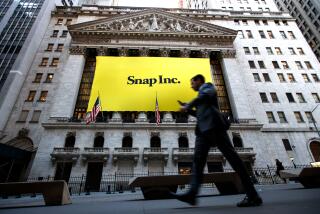Can Snap’s stock make a comeback like Facebook’s?

A tech company makes a much-hyped stock market debut. (May 12, 2017) (Sign up for our free video newsletter here http://bit.ly/2n6VKPR)
- Share via
Fresh off its stock market debut, the much-hyped tech start-up quickly saw the euphoria, riches and huge expectations fade. Panicked investors fretted over the firm’s first earnings report, sending stock prices tumbling like never before.
It’s the story of Snap Inc. — but also the history of Facebook.
The question now is whether the makers of Snapchat can produce a comeback as dramatic as Facebook’s.
After seeing the company’s value slashed in half to $50 billion about three months after its 2012 stock market debut, Facebook proved the fears were overblown by doubling expected ad sales for its mobile app. Facebook rebounded, and now has a market capitalization of more than $430 billion.
So when Snap — a social media firm also founded by a self-confident college dropout with big ideas on how people communicate — sought to go public, investors couldn’t help but imagine another meteoric rise.
That paid off for the Los Angeles company, which in March held the biggest initial public offering of a tech company since Facebook. But after issuing its first earnings report, the Los Angeles-based maker of Snapchat similarly finds itself in the hot seat.
Snap lost more than a fifth of its value Thursday as investors disappointed in the company’s ad sales growth dumped $2.3-billion in shares.
Financial analysts hold mixed views on whether Snap, now valued at about $21 billion, can experience a Facebook-like rise to the upper tier of the technology world.
When Facebook shares cratered five years ago, the company had nearly 1 billion users and solid ad business outside of its mobile app.
By comparison, Snap has 166 million users on its messaging app, and new ones are coming in the door slower than any point in the last two years. Its ad business is nascent.
The risk for Snap is that it could end up more like Twitter Inc. after its 2013 stock debut. The microblogging service suffered a similar sell-off following its first earnings report; its shares currently trade at half their value when Twitter went public.
“It’s a tale of two cities,” said Goodwater Capital managing partner Eric Kim. “It’s really about how the company will respond going forward — Facebook came out of it and increased its market cap fourfold; Twitter has not. So what does Snap learn from this initial debut? What lessons does it take with it?”
The amount of time Snap has to straighten its course may depend on whether it can satisfy one of Wall Street’s favorite measurements for success: user growth.
Snap, for its part, has said its success should be measured in revenue per user — ad income divided by the number of users — instead of user growth. Ahead of reporting its earnings, the company cautioned that it wasn’t likely to pick up new users at the exceptional pace of the past and that growth would be “lumpy,” with quarterly variances depending on when new features are launched.
Such messaging didn’t appear to ease doubts.
Another reason for concern is Snap’s ad revenue performance. Ad sales often fall off early in the year across the media landscape, but many investors predicted Snap as a young company would be immune from the trend. They found out in the company’s first quarterly earnings report Wednesday that Snap not only succumbed to the usual dip, but also that its $150 million in revenue represented a harder blow than those suffered by more established ad sellers.
“Most social marketers already complain about Snapchat’s lack of user data and proper social measurement,” said Jessie Liu, who follows online advertising for Forrester Research. “It’s one thing to say on the earnings call that they intend to do a better job of delivering metrics to prove ad effectiveness, but they have to execute and prove this to advertisers.”
It’s aggressive to expect the market to support a valuation that high without having a lot of strong underpinnings.
— Michael Nathanson of the stock-research firm MoffettNathanson
Snap is trying to convince advertisers to buy novel types of commercials, including vertically-displayed, 10-second videos that users can skip in a millisecond and funny facial animations that users must like enough to spread to friends.
“The big issue with advertising over the next decade or so, frankly, is going to be education,” Snap Chief Executive Evan Spiegel told analysts Wednesday. “Early adopters are seeing great results. And so we’ve just got to keep showing people how Snap can really work for them and drive [a return on investment].”
But investors wanted to be wowed by Wednesday’s earnings report, leaving them questioning whether Snap shares will generate enough demand to sustain a price attractive to job candidates, suitable to buy smaller companies and defensible against take-over offers.
Snap shares closed Thursday at $18.05, down 21.4% from their price before earnings were released Wednesday afternoon. The stock listed at $17, debuted at $24 and reached a peak of $27.09 the day after its IPO.
The price is sure to suffer another big decrease mid-summer when employees and other shareholders required to hold shares for a certain period become free to sell.
Several analysts at firms marketing Snap shares said investors shouldn’t read too deeply into the company’s stumbling at the starting gate.
“Way too early,” wrote Mark Mahaney of RBC Capital Markets. Mahaney maintained his estimate that shares should hit $31 next year.
Snap critics such as Richard Windsor of Edison Investment Research took the results as evidence of its case that Snap isn’t worth close to its current price.
“Management even had the temerity to laugh off the threat from its much larger and far more powerful rival, Facebook, which is successfully replicating Snap’s innovations to great effect,” Windsor said of Spiegel’s comments Wednesday brushing off Faceboook Inc.’s copycat video-sharing technology.
Michael Nathanson of the stock-research firm MoffettNathanson said Snap has exposed investors to significant losses by going public earlier than it should have.
“Given the immaturity of its revenue model, it’s just asking for a lot from the investment community,” Nathanson said. “It’s aggressive to expect the market to support a valuation that high without having a lot of strong underpinnings.”
Even analysts at Goldman Sachs, who hold a positive outlook on Snap, acknowledged Thursday that Snap remains the kind of risky bet that should be the target of venture capital firms as opposed to mutual funds and individuals.
Snap’s stock could drop further until the company resets investor expectations about how fast and how big it will grow — a process that could take as long as five years, Spiegel told the Los Angeles Times in March. Connecting one-third of the planet as Facebook has done may never be possible for Snap.
If investors can accept that possibility then they will have to decide the value of a niche service that could prove better at advertising to millennials and Generation Z behind them than anyone else.
“You have a large number of very engaged [consumers] dealing in the most immersive form of video the world has ever known,” said Alex Collmer, chief executive of Snapchat ad technology partner VidMob. “People are focusing on things that are more temporary and missing that sort of macro picture.”
VidMob’s software has helped hundreds of companies repeatedly develop video ads for distribution on Snapchat. And Collmer said once companies see that the process can take as little as two days, they’re hooked.
Still, Snap, just like Facebook, Twitter, YouTube and many other online services, must get thousands more companies to see the value in their ad offerings compared with those of TV, newspapers and other legacy media.
“What Snap is going through is no different than what everyone else is going through,” Collmer said, except that it might be more exposed as a new, vastly hyped entrant on the market.
Times staff writer Tracey Lien contributed to this report.
Twitter: @peard33
Twitter: @dhpierson
MORE ON SNAP
Snap isn’t the only tech firm to get hammered after its first earnings report
Hiltzik: We told you the Snap IPO was a sucker’s bet, and its first quarterly report shows why
Snapchat launches its take on Instagram’s Boomerang and Photoshop’s magic eraser and custom brushes








